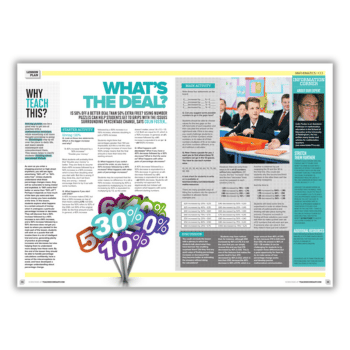Is 50% off a better deal than 50% extra free? This percentage change KS3 lesson helps students get to grips with the issues surrounding percentage change…
Percentages crop up all over the place in daily life, and many people misinterpret and misunderstand them. This lesson helps to clarify students’ thinking about percentage change.
As soon as you enter a shopping precinct or high street anywhere, you will see signs advertising “50% off” or “50% extra free”. Unless students understand what these percentage changes mean, they will be vulnerable to being misled and exploited.
Is “50% extra free” better or worse than “50% off”? Perhaps it depends on how much of the item you want and how much money you have available at the time.
In this percentage change KS3 lesson, students explore what happens to a certain amount of money when it undergoes a particular percentage increase or decrease. They will discover that a 50% increase followed by a 40% increase is not a 90% increase, and a 50% increase followed by a 50% decrease does not get you back to where you started!
In the main part of the lesson, students will work on a puzzle that will involve them in a lot of intelligent trial and error, generating plenty of practice at percentage increases and decreases but also helping them to understand more deeply how these work.
By the end of the lesson they should be able to handle percentage calculations confidently, have a sense of the misconceptions to avoid, and have developed a stronger understanding about percentage change.
Colin Foster is an assistant professor in mathematics education in the School of Education at the University of Nottingham. He has written many books and articles for maths teachers. Browse more KS3 maths games and lesson ideas.











